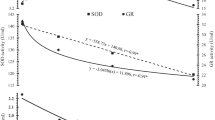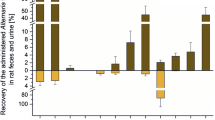Abstract
Aflatoxin B1 metabolism was studied using microsomal and cytosolic fractions isolated from weanling male Fischer F344 rats given in drinking water for 7 days an aqueous extract ofSacoglottis gabonensis bark, 0.1% ethanol solution, or a solution containing both extract and ethanolad libitum. Microsomal production of aflatoxin B1-dihydrodiol, aflatoxin Q1, aflatoxin M1, aflatoxin Pi and proteinaflatoxin adduct formation, and cytosolic aflatoxin B1-glutathione conjugation were assayed. Pretreatment with the extract alone or together with ethanol caused significant increases in aflatoxin M1 production as compared to controls given only water, but aflatoxin Q1 production was enhanced only by pretreatment with both extract and ethanol. All the three treatments caused significant reductions in liver glutathione content. The highest aflatoxin B1 metabolising activity as determined by aflatoxin M1 and aflatoxin Q1 production was observed in rats pretreated with both ethanol and the extract, suggesting synergism. The findings suggest that at relatively mild doses,S. gabonensis extract alone or in concert with ethanol may influence response to aflatoxin.
Similar content being viewed by others
References
Wogan GN, Newberne PM (1967) Dose-response characteristics of aflatoxin B1 carcinogenesis in the rat. Cancer Res 27:2370–2376
Linsell CA, Peers FG (1977) Aflatoxin and liver eel cancer. Trans R Soc Trop Med Hyg 71:471–473
Ngindu A, Kenya PR, Ocheng DM, Omondi TN, Ngare W, Gratei D, Johnson BK, Ngira JA, Nandwa H, Jansen AJ (1982) Outbreak of acute hepatitis caused by aflatoxin poisoning in Kenya. Lancet 1:1346–1348
Nwokolo C, Okonkwo P (1978) Aflatoxin load of common food in savannah and forest regions of Nigeria. Trans R Soc Trop Med Hyg 72:329–332
Onyemelukwe G, Ogbadu G (1981) Aflatoxin levels of sera of healthy first time rural blood donors: preliminary report. Trans R Soc Trop Med Hyg 75: 780–782
Onyemelukwe GC, Ogbadu GH, Salifu A (1982) Aflatoxins B1, B2, G1, and G2 in primary liver cell carcinoma. Toxicol Lett 10:309–312
Miller EC (1978) Some current perspectives on chemical carcinogenesis in humans and experimental animals: presidential address. Cancer Res 38:1479–1496
Degen GH, Neumann HG (1981) Differences in aflatoxin B1-susceptibility of rat and mouse are correlated with the capabilityin vitro to inactivate afla-toxin B1 epoxide. Carcinogenesis 2:299–306
Neal GE, Judah DJ, Stirpe F, Patterson DSP (1981) The formation of 2,3-dihydroxy-2,3-dihydro-aflatoxin B1 by the metabolism of aflatoxin B1 by liver microsomes isolated from certain avian and mammalian species and the possible role of this metabolite in the acute toxicity of aflatoxin B1. Toxicol Appl Pharmacol 58:431–437
O’Brien K, Moss E, Judah D, Neal G (1983) Metabolic basis of the species difference to aflatoxin B1 induced hepatotoxicity. Biochem Biophys Res Commun 114:813–821
Lieber CS, Seitz HK, Garro AJ, Worner TM (1979) Alcohol-related diseases and carcinogenesis. Cancer Res 39:2863–2886
Obidoa O, Okolo TC (1979) Effect of ethanol administration on the metabolism of aflatoxin B1. Biochem Med 22:145–148
Toskulkao C, Glinsukon T (1986) Effect of ethanol on thein vivo covalent binding andin vitro metabolism of aflatoxin B1 in rats. Toxicol Lett 30:151–157
Toskulkao C, Taycharpipranai S, Glinsukon T (1982) Enhanced hepatotoxicity of aflatoxin B1 by pretreatment of rats with ethanol. Res Commun Chem Pathol Pharmacol 36:477–491
Ekong DEU, Ejike C (1974) Antioxidant principles from the barks ofSpondianthus preussi (Family Euphorbiaceae) andSacoglottis gabonensis (Family Humiriaceae). J W Afr Sei Assoc 19:63–68
Neal GE, Colley PJ (1978) Some high-performance-liquid-chromatographic studies of the metabolism of aflatoxins by rat liver microsomal preparations. Biochem J 174:839–851
Neal GE, Green JA (1983) The requirement for glutathione-S-transferase in the conjugation of activated aflatoxin B1 during aflatoxin hepatocarcinogenesis in the rat. Chemico-Biol Interact 45:259–275
Lowry OH, Rosebrough NJ, Farr AL, Randall RJ (1951) Protein measurement with the Folin phenol reagent. J Biol Chem 193:265–275
Omura T, Sato R (1964) The carbon monoxide-binding pigment of liver microsomes. I. Evidence for its haemoprotein nature. J Biol Chem 239:2370–2378
Ellman GL (1959) Tissue sulfhydryl groups. Arch Biochem Biophys 82:70–77
Beutler E, Duron O, Kelly BM (1963) Improved method for the determination of blood glutathione. J Lab Clin Med 61:882–886
Johnson MK (1966) Preparation of deproteinised tissue extracts for chromatography and assay of compounds related to glutathione. J Chromatogr 23:474–475
Dahms R, Gurtoo HR (1976) Metabolism of aflatoxin B1 to aflatoxins M1 and P1 by mouse and rat. Res Commun Chem Pathol Pharmacol 15:11–20
Campbell TC, Hayes JR (1976) The role of aflatoxin metabolism in its toxic lesions. Toxicol Appl Pharmacol 35:199–222
25 Moss EJ, Judah DJ, Przybylski M, Neal GE (1983) Some mass-spectral and nmr analytical studies of a glutathione conjugate of aflatoxin B1. Biochem J 210:227–233
26 Degen GH, Neumann HG (1978) The major metabolite of aflatoxin B1 in the rat is a glutathione conjugate. Chemico-Biol Interact 22:239–255
27 Mgbodile MUK, Holscher M, Neal RA (1975) A possible protective role for reduced glutathione in aflatoxin B1 toxicity: Effect of pretreatment of rats with phenobarbital and 3-methylcholanthrene on aflatoxin toxicity. Toxicol Appl Pharmacol 34:128–142
28 Boyland E, Chasseaud LF (1969) The role of glutathione and glutathione-S-transferase in mercapturic acid biosynthesis. Adv Enzymol 32:173–185
Author information
Authors and Affiliations
Rights and permissions
About this article
Cite this article
Okoye, Z.S.C., Neal, G.E. Synergistic effect ofSacoglottis gabonensis bark extract,. Mycotox Res 4, 37–43 (1988). https://doi.org/10.1007/BF03192088
Received:
Accepted:
Issue Date:
DOI: https://doi.org/10.1007/BF03192088




